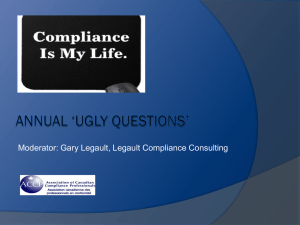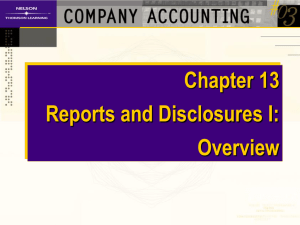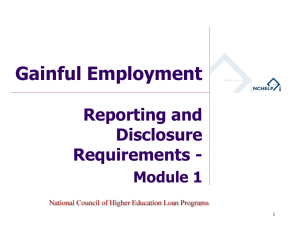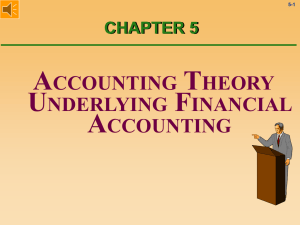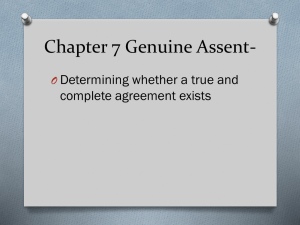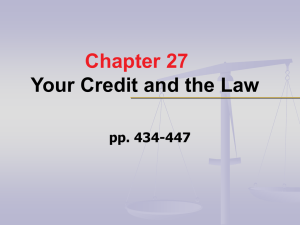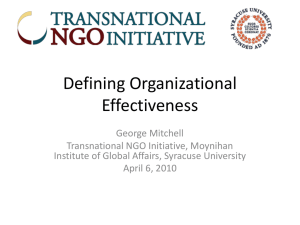Part3Beall_PaulBasicZ-05 - American Association of residential
advertisement
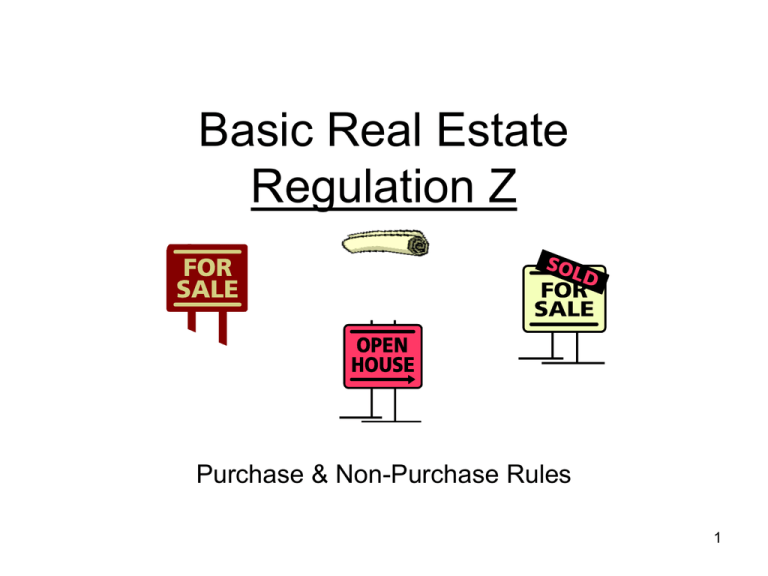
Basic Real Estate Regulation Z Purchase & Non-Purchase Rules 1 Learning Objectives • Learn about the regulatory requirements of Regulation Z by reviewing the: – Basic rules for Purchase-money real estate transactions and – Basic rescission rules for Non-purchase money real estate transactions • Review the risks when errors occur – Legal – Reputation – Regulatory 2 Introduction • Lifecycle of a Real Estate Loan – Pre-Closing Disclosures – Closing Disclosures – Post-Closing Disclosures • Application procedures are discussed in the Basic B Lecture 3 Pre-Closing - Regulation Z 4 Providing Early Disclosures • When are TIL disclosures required to be provided to borrowers? 5 Providing Early Disclosures • Section 226.17(b) – Before Consummation • This is a general rule that requires the creditor to provide disclosures to the consumer before consummation of the transaction. • Staff Commentary #3 – It is not sufficient for the creditor merely to show the consumer the document containing the disclosures before the consumer signs and becomes obligated. The consumer must be free to take possession of and review the document in its entirety before signing. • Section 226.19(a) – Within 3 days of Application • A “residential mortgage transaction” has a special timing rule that requires a good faith estimates of the disclosures required by section 226.18 to be provided within three business days of written application or consummation, whichever is earlier – Exception if denied within the three-day period 6 Residential Mortgage Transaction • What is a “residential mortgage transaction?” – A transaction to finance the purchase or construction of the consumer’s principal dwelling • Are early disclosures different from the final disclosure? – Not really, the early disclosure is not based on the legal obligation but is a good faith estimate of the transaction 7 Early Disclosures • Special Rule – Early disclosures can be the final disclosure if the APR at closing does not change by more than tolerance (1/8 of 1 percent regular) – However, most banks automatically provide the final disclosure regardless of this rule 8 Early Disclosure • Which disclosure do you check when two are provided? (early & final) – Both, Maybe • What happens when the early disclosure is incorrect and the final is correct? – The courts would probably rule against the bank if the early is wrong. 9 Early Disclosure • While the early disclosure is not based on the legal obligation, lenders can use the GFE could serve as a proxy for the legal obligation when calculating the early disclosure as the regulation only requires a good faith estimate. • ****Make sure the math is correct. 10 Closing Disclosures - Regulation Z 11 Objectives • Basis for Disclosures – What the TIL Disclosure should Disclose • Calculations – Make sure the numbers right – Learn how to check a disclosure calculation • Preventing Legal, Reputation & Regulatory Risks – – – – Civil Liability Communication of Errors Regulatory Enforcement Internal Reviews • Rescission Rules – Non-Purchase Money Transactions 12 Basis for Disclosures 13 Basis for Disclosures • Legal Obligation – The TIL disclosure shall reflect the terms of the legal obligation (other than the early disclosure) • Unknown Information – If any information is unknown, disclosures shall be based on the best information reasonably available at the time of the disclosure • clearly state the disclosure is an estimate • ARM loans based on today’s rates (do not use estimates) • Construction loans using Appendix D will use estimates 14 Basis for Disclosures • Special Rule – Per Diem Interest – Section 226.17(c)(2)(ii) allows creditors to disclose per diem interest based on information known to the creditor at the time that the disclosure documents are prepared for consummation of the transaction. – In other words, if the loan closing is postponed by a day or two, the pre diem interest on the final disclosure, prepared in advance, would be correct even if the actual charge differs by the time disclosures are provided to the borrower. • The Board notes that creditors should exercise diligence in ascertaining the correct information when preparing disclosures. 15 Basis for Disclosures • The Staff Commentary for Regulation Z includes rules for preparing disclosures with unusual terms – Examples include: • • • • consumer buydowns wraparound financing graduated payment mortgages reverse mortgages • Any lenders making unusual loans?? 16 Disclosure Calculations The Note The Payment Schedule The Amount Financed The Finance Charge The APR 17 Calculations • Once the basis for the TIL disclosure is determine, it is time to calculate required information • Compliance Officers should understand this method even if other staff members or outside consultants perform the periodic reviews 18 The Note 19 The Note • Start with the Legal Obligation – Identify the loan amount • The loan amount in the note is used to verify the amount financed on the TIL disclosure – Review the contract terms • Note rate • Terms • Payment amounts • If an ARM note, the specific rate change terms – – – – Index value Rate caps Rate margins Rounding – Are the note terms correct? • Errors are legal issues that must be resolved before a correct TIL disclosure can be developed 20 The Payment Schedule 21 The Payment Schedule • Determine the Payment Schedule – Number of payments – Timing of payments • Use the amounts and time period listed in the note (legal obligation) – Verify the payment calculation Note Example link • Is the math correct? – – – – Does the loan amount @ the interest rate @ the # of payments = the payment amount • If not, you may have a legal problem first 22 The Amount Financed 23 The Amount Financed • Verify the Amount Financed • Principal loan amount (not always the note amt) • Plus any other amounts financed • Minus any prepaid finance charge – This in a independent calculation. You should not rely on the TIL disclosure for this amount. – Again, look at the note it is your starting point 24 The Amount Financed • What documents do you need to calculate the amount financed? • Two Documents – The Note-To verify the loan amount – The HUD-1- To determine the prepaid finance charges 25 The Amount Financed • What is a prepaid finance charge? • Defined in Regulation Z Section - 226.2(a)(23) – It is a finance charge paid separately in cash or by check before or at consummation of a transaction, or withheld from the proceeds of the credit at any time. 26 The Amount Financed • You must know what charges are finance charges before can identify what charges are prepaid when determining the amount financed – HUD 1 is the document to review 27 The Finance Charge What is it? 28 The Finance Charge • A Finance Charge is a specific charge listed in Section 226.4 – Includes exemptions – Special rules • Don’t be fooled – This section does not list every charge possible. – This is the Regulation Z conundrum 29 The Finance Charge • Third Party Charges - 226.4(a)(1) – Paid to someone other than creditor – Creditor requires use of third party, or – Retains a portion of charge • Example - PMI 30 The Finance Charge • Closing Agent Charges - 226.4(a)(2) – Fees charged by third parties to conduct loan closing – Creditor requires service or – Retains a portion of the charge • Can be exempt if part of a lump-sum closing fee and represents only a small portion of the total 31 The Finance Charge • Mortgage Brokers Fees - 226.4(a)(3) – Always considered a finance charge – Even if creditor does not require use of the broker or retain a portion of the charge 32 The Finance Charge • Listed Charges - 226.4(b) – – – – points origination fees appraisal credit report • Regulation Z does not list all possible charges or have the same name for each charge 33 The Finance Charge • Excluded Amounts - 226.4(c) – Application fee • if charged to all applicants – Sellers points • Charges not paid by the borrower – Real estate related fees -4(c)(7) • Most important section 34 The Finance Charge • Excluded Amounts - 226.4(c) – Real estate related fees -4(c)(7) • (i) Fees for title examination, abstract of title, title insurance, property survey, and similar purposes. • (ii) Fees for preparing loan-related documents, such as deeds, mortgages, and reconveyance or settlement documents. • (iii) Notary and credit-report fees. • (iv) Property appraisal fees or fees for inspections to assess the value or condition of the property if the service is performed prior to closing, including fees related to pest-infestation or flood-hazard determinations. • (v) Amounts required to be paid into escrow or trustee accounts if the amounts would not otherwise be included in the finance charge. 35 Verify the Amount Financed • Review a copy of the HUD-1 • Know which amounts paid by the borrower are finance charges • Those that are paid at or before closing are “prepaid finance charges” 36 Example • Note Amount – should include all amounts financed along with proceeds • Subtract HUD-1 Prepaid finance charges • $100,000 Note Amount -1,500 PPFC 98,500 Amount Financed – Make sure you add the PPFC back in the finance charge 37 Verify the APR 38 Verify the APR • Independent Calculations – Amount Financed – Payment Schedule • Once the amounts are independently verified, you are ready to verify the disclosed APR using an independent calculation method 39 Verify the APR • The OCC’s APR windows program is currently used by most examiners to verify TIL disclosure calculations – Excellent tool for bank compliance officers for internal review checks 40 APR Rules Special rules for real estate loans 41 APR Calculation Rules • Section 226.22 of Regulation Z contains rules for APR calculations along with the specific mathematical calculation in Appendix J • Special Mortgage Rules – The $100 rule • Found in section 226.22(a)(4) – The Additional Tolerance Rule • Found in Section 226.22(a)(5) 42 APR Calculation Rules • The $100 Rule – If the annual percentage rate disclosed in a transaction secured by real property or a dwelling varies from the actual rate determined in accordance with Appendix J of Regulation Z, in addition to the tolerances applicable under paragraphs (a)(2) – [1/8%] and (3)- [1/4%] of this section, the disclosed annual percentage rate shall also be considered accurate if— – (i) the rate results from the disclosed finance charge; and – (ii) • (A) the disclosed finance charge would be considered accurate under section 226.18(d)(1) [is understated by no more than $100]; or • (B) for purposes of rescission, if the disclosed finance charge would be considered accurate under section 226.23(g) or (h), whichever applies. 43 APR Calculation Rules • The Additional Tolerance Rule – In a transaction secured by real property or a dwelling, in addition to the tolerances applicable under paragraphs (a)(2) and (3) of this section, if the disclosed finance charge is calculated incorrectly but is considered accurate under section 226.18(d)(1) or section 226.23(g) or (h), the disclosed annual percentage rate shall be considered accurate— • (i) if the disclosed finance charge is understated, and the disclosed annual percentage rate is also understated but it is closer to the actual annual percentage rate than the rate that would be considered accurate under paragraph (a)(4) of this section; • (ii) if the disclosed finance charge is overstated, and the disclosed annual percentage rate is also overstated but it is closer to the actual annual percentage rate than the rate that would be considered accurate under paragraph (a)(4) of this section. 44 APR Calculation Rules • Example: » $75.00 understatement – $100 • ____________________________ • 8.40 8.50 8.65 8.875 9.00 9.125 • Assume: – $75 understatement – .125% Tolerance – 9.00% Correct APR 45 The TIL Disclosure Review 46 Regulation Z • Disclosure Review – In addition to verifying the calculations for the APR and finance charge, you should review the TIL disclosure form for compliance with other required disclosure information outlined in Section 226.18 • Review key terms that have special real estate significance 47 Regulation Z • Disclosure Review - 226.18 – Amount financed • Know what a prepaid finance charge is – Itemization of amount financed • footnote 40 – Good faith estimate can be a substitute – Finance Charge • Know how the $100 rule applies 48 Regulation Z • Disclosure Review - 226.18 – Variable Rate • If the annual percentage rate may increase after consummation in a transaction secured by the consumer's principal dwelling with a term greater than one year, the following disclosures: • (i) The fact that the transaction contains a variable-rate feature. • (ii) A statement that variable-rate disclosures have been provided earlier. 49 Regulation Z • Disclosure Review - 226.18 – Security Interest • Spreader clause & Rescission – Security Interest Charges • “filing fees and taxes,” and all funds disbursed for such purposes may be aggregated in a single disclosure. • This disclosure may appear, at the creditor's option, apart from the other required disclosures. – The inclusion of this information on a statement required under the Real Estate Settlement Procedures Act is sufficient disclosure for purposes of Truth in Lending. 50 Regulation Z • Disclosure Review - 226.18 – Assumption policy. • In a residential mortgage transaction, a statement whether or not a subsequent purchaser of the dwelling from the consumer may be permitted to assume the remaining obligation on its original terms. 51 Regulation Z • Another Disclosure – Rate Limitation 226.30 • While not a calculation, when looking at the note, check for this disclosure • Special Rule relating to the Note • Lenders must include in a consumer credit contract (Note) secured by a dwelling the maximum interest rate that may be imposed during the loan term 52 Legal, Reputation, Regulatory Risks Understated Disclosures 53 Disclosure Risks • What is the highest risk violation when making a consumer loan? – APR & Finance Charge Understatement violations on real estate loans • What should your bank do to reduce legal and reputation risk? – Know the legal liability limits – Implement internal reviews 54 Legal Risks • Civil Liability - TILA - Section 130(a) • ….any creditor who fails to comply with any requirement imposed under this chapter…with respect to any person is liable to such person in an amount equal to the sum of— – any actual damage sustained by such person as a result of the failure; • in the case of an individual action twice the amount of any finance charge…. not be less than $100 nor greater than $1,000, • in the case of a closed-end credit plan that is secured by real property or a dwelling, not less than $200 or greater than $2,000; • in the case of a class action, such amount as the court may allow, except that…shall not be more than the lesser of $500,000 or 1 per centum of the net worth of the creditor; 55 Legal Risks • Civil Liability - TILA - Section 130(b) – Correcting Errors – No liability…, if within sixty days after discovering an error, and prior to the institution of an action under this section or the receipt of written notice of the error from the obligor, • the creditor or assignee notifies the person concerned of the error and makes whatever adjustments in the appropriate account are necessary to assure that the person will not be required to pay an amount in excess of the charge actually disclosed, or the dollar equivalent of the annual percentage rate actually disclosed, whichever is lower. 56 Legal Risks • Bottom Line – Original Disclosure Stands • Must ensure consumer does not pay any more than the APR Disclosed • Banks have 60 days to fix it to avoid law suits, once an error is identified – Sending a new disclosure will not fix the problem or reduce legal liability!!!! 57 Reputation Risks • Notifying customers – Contacting customer about disclosure errors will spread the word creating a reputation risk for the bank • Regulator Enforcement – If the regulators find the errors, they can order the banks to make customer reimbursements • This can lower the compliance rating and may require public disclosure of the errors when a formal “written agreement” is issued by the regulators 58 Regulatory Risk • Section 108(e) of the TIL gives the regulators authority to require banks to make customer reimbursements for certain violations of the Act. • Agencies adopted: – The “Joint Policy Statement on Administrative Enforcement of the Truth in Lending Act—Restitution” (The Policy Guide) to carry out the provisions of the TILA 59 Regulatory Risk • The Policy Guide authorizes the federal Truth in Lending enforcement agencies to order creditors to make monetary and other adjustments to the accounts of consumers in cases where disclosures were inaccurate for the: – Annual Percentage Rate – Finance Charge 60 Bottom Line • Either the Bank makes the reimbursement or the Regulator may order it • Generally reimbursement will be required for errors resulting from a clear and consistent pattern or practice of violations, gross negligence, or a willful violations – The act does not preclude the agencies from ordering restitution for isolated disclosure errors. 61 Internal Review 62 Internal Review • Who should conduct the Review? • What special tools are required? • What is the bank’s reimbursement policy? 63 Internal Review • Who should conduct the Review? – Line Management – Compliance Staff – Audit Staff • Line Management – Most internal compliance reviews should be conducted by the line management area where the compliance function is performed – For example: • Consumer Lending should review TIL disclosures for compliance if the disclosures require line input 64 Internal Review • Who should conduct the Review? – Compliance Staff • They could review software programs before implementation in the Line area – Audit • They could review the internal review programs of the line and compliance functions 65 Internal Review • What special tools are required? – Disclosure Reviews • Line and compliance staff should have independent calculation tools to verify key TIL disclosure calculations • OCC- APR Software program – Do not use the disclosure generation program to check disclosures!!!! 66 Internal Review • What is the bank’s reimbursement policy? – Business, Legal, Regulatory Decisions • Business Decision – Low risk, do nothing (still has legal risk) • Legal Decision – High risk action must be taken to prevent law suits • Regulatory Decision – No choice, It’s an order 67 Rescission Rules Non-Purchase Money Transactions 68 Rescission Rules • What is the right of rescission? – A consumer credit transaction – Secured by a consumer's principal dwelling – Each owner shall have the right to rescind the transaction (Cancel the deal) • When more than one consumer in a transaction has the right to rescind, the exercise of the right by one consumer shall be effective as to all consumers. 69 Rescission Rules • Origins of Rescission – Contractor Credit Transactions • Lightening Rod Sales • Aluminum Siding Sales 70 Rescission Rules • Does it apply to all Real estate transactions? – No • Credit extensions not subject to the regulation are not covered – For example, rescission does not apply to a business-purpose loan, even though the loan is secured by the customer's principal dwelling. • Other exemptions – Generally not applicable to transactions involving the purchase or construction of the principal dwelling 71 Rescission Rules • Specific Exemptions – Residential Mortgage Transaction • a transaction in which a security interest is created or retained in the consumer's principal dwelling to finance the purchase or initial construction of that dwelling. – Combination purchase/improvement loan – Refinancing same creditor (no new money) – A series of advances (other than an initial advance) or a series of single-payment obligations that is treated as a single transaction, if the rescission notice and all material disclosures have been given to the consumer at consummation. 72 Rescission Rules • Timing – Consumer can exercise the right of rescission until the last event occurs • Midnight of the third business day following consummation • Delivery of the rescission notice • Delivery of all material TIL disclosures – If all three events have not occurred, rescission period extends for three years after consummation 73 Rescission Rules • Notice shall disclose the following: – Lender has retained a security interest in the consumer’s principal dwelling – Consumer has right to rescind the transaction – How to exercise right to rescind, a written form for that purpose, creditors address, effects of rescission – Date the rescission period expires 74 Rescission Rules • Model Forms – Appendix H of Regulation Z contains model forms for rescission – H-9 is for refinancing 75 Rescission Rules • Disbursing Funds – Rescission rules prohibit the creditor from disbursing any money to the consumer other than for escrow until rescission period expires – Violations are common for this provision • Understanding the Waiver rules can reduce violations 76 Rescission Rules • Waiver – Consumers can waive the rescission period if: • There is a “bona fide personal financial emergency” • The consumer has signed and dated a written statement of the emergency – Can not be on a preprinted form 77 Rescission Rules • Waiver Form Bank of Anywhere, Anywhere, USA I/We would like to waive the rescission period on my/our mortgage loan due to the following financial emergency: __________________________________________________ __________________________________________________ __________________________________________________ Customer Name_____________________ Date_______________________ • *******Can not use a preprinted form 78 Rescission Rules • Waiver – What is an example of a good or bad waiver? • Loan to repair the dwelling’s heating system during the cold winter • Loan to take a winter vacation to Sunny Florida 79 Rescission Rules • When Rescission Occurs: • The Security Interest becomes void • Creditor shall return all money collected including any finance charges to the consumer within 20 days of notice to rescind and terminate the security interest • Consumer shall return any money or property received from the creditor after the creditor returns the consumer’s funds – If the creditor does not take possession of the money or property within 20 calendar days after the consumer's tender, the consumer may keep it without further obligation. 80 Rescission Rules • Rescission Tolerances – One-half of one percent • Finance charge is considered accurate if it is understated by no more that 1/2 of 1 percent of the face amount of the note or $100 whichever is greater on a “regular” rescission transaction – One percent • Finance charge is considered accurate if it is understated by no more than1 percent of the face amount of the note or $100 whichever is greater on a “refinancing”rescission transaction with a new creditor 81 Rescission Rules • Rescission Tolerances Foreclosures – After initiation of foreclosure the consumer shall have the right to rescind if • a mortgage broker fee was not disclosed in the finance charge • creditor did not provide a proper rescission notice • finance charge is understated by more then $35 82 Post Closing - Regulation Z 83 Subsequent Disclosure Requirements • Assumptions - 226.20(b) – In Writing • An assumption occurs when a creditor expressly agrees in writing with a subsequent consumer to accept that consumer as a primary obligor on an existing residential mortgage transaction. – New Disclosures • Before the assumption occurs, the creditor shall make new disclosures to the subsequent consumer, based on the remaining obligation. 84 Questions??? 85
